1985
There were seventy-nine calls recorded during the year, with the usual variety of activities. These included a fire at a refuse tip, a flooded cellar at Radway, a chemical spillage on the road, two bomb alerts at Kineton, three vehicle fires, four Road Traffic Accidents, eight farm fires with three barns, fifteen false alarms, eighteen chimney fires and twenty-six house or building fires.
In February the crew was called to a chimney fire at Little Kineton, but was unable to get through as the road was blocked by snow two feet deep.
A call to cottages at Mill Lane, Kineton one morning, where bedrooms were on fire, was followed the same night by a return call to fire in the roofs of the same cottages, where eight B.A. sets and one jet was used with four hose-reels.
In November a call to a fire in Kineton Church revealed that the nave was full of smoke down to about five feet from the floor. The only way to clear the smoke was to open all doors up in the tower. Fireman Billing and Fireman Morgan were sent up wearing B.A. sets, which made access somewhat difficult. This soon became one of the noisiest jobs of the year as the two fireman struggled for space, wearing the bulky B.A. sets and clanging the bells on their way out on to the roof. The cause of the fire was identified as arson.
In one of the traffic accidents, a man was killed at Lower Brailes, and in another incident on Sunrising Hill a tractor and trailer overturned and had to be cut apart with Epco and a Cengar Saw.
In a fire at Doctors Barn, Whichford, the snow was blowing horizontally in high winds and extreme cold. In another fire, at Northend, the nearest water supply was sixty-one hose lengths away from the fire, and all available hose was run out from the hydrant to the fire. The water, however, was flowing over frozen ground, and, having reached a coupling in the hose, it froze solid. Fireman Eden was holding a branch with steam coming off the front of his tunic and icicles hanging off the back!
1986
Eighty-five calls were recorded, including one tree fire, two stand-by duty calls, sixteen chimney fires, five farm fires, one of which was a barn, twenty-seven false alarms, five Road Traffic Accidents, two special service calls (to oil and waste at Willington, and to a gas leak at Shipston), five car fires and twenty-two house or building Fires.
The high incidence of false alarm calls was clearly an ongoing problem over the years.
In one of the traffic accidents, on the Wroxton St Mary to Shutford Rd, a Land Rover had overturned into a ditch and the driver died from the effects of a large quantity of extremely poisonous cyanide.
Police Officers and ambulance crews were also nearly overcome whilst helping to remove the driver. A water relay was run from Wroxton St Mary, with six pumps, some 400 meters along the Shutford Road in order to decontaminate the area.
At a fire in the garage at Lower Nineveh, on the Whatcote to Brailes Road, several cars, two oxygen cylinders and two acetylene cylinders were alight. This required two jets, two men with B.A. sets and hose reels. The cylinders were still red hot, so they were first put into a dam of water made from ladders and a sheet, before being moved by the firemen on their shoulders to a pond in a field some 400 metres away. This was on the orders of the Assistant Divisional Officer.
At West End, Radway the crew attended a fire in a row of thatched cottages, which had corrugated iron sheets fixed on top of the thatch. Since the thatch was burning under the iron sheets, the heat build-up was intense, making the removal of the bolted together sheets virtually impossible. Two members of the crew, wearing breathing apparatus, were inside the cottage when the front wall and the roof fell in. They were fortunate to ‘shelter’ under the wooden stairs as the burning roof came down, and they were relieved to be only ‘shaken up’ when the other crews got them out.
The Jag was replaced during the year by a similar Jaguar, registered RAC 999M.
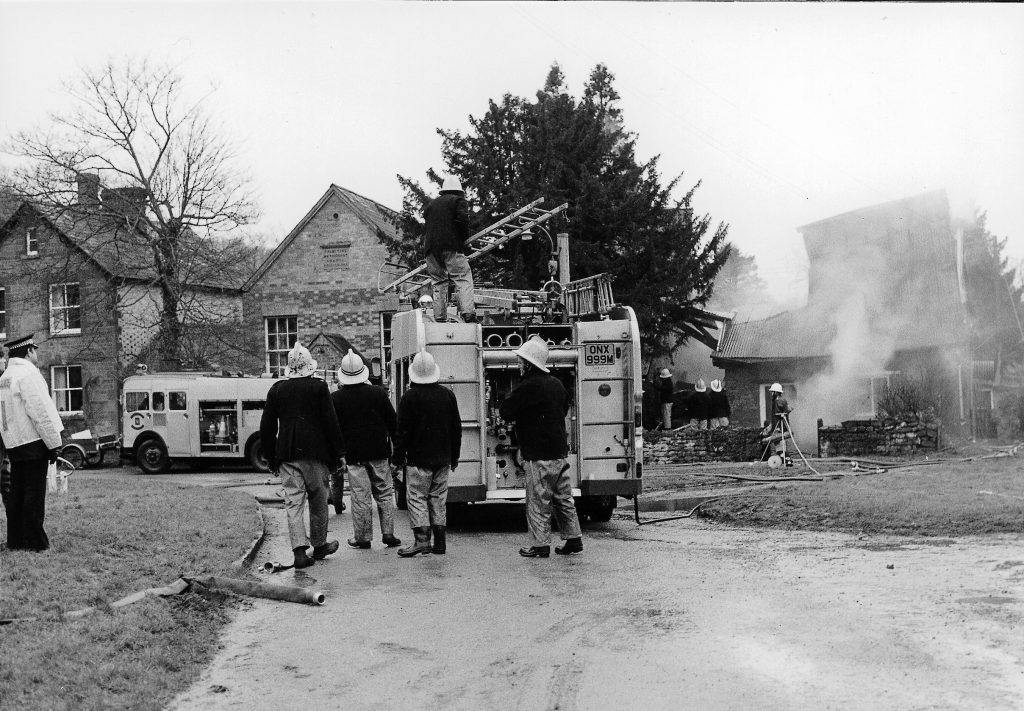
Tysoe Fire Station, together with Fenny Compton Fire Station, was once again a target for closure.
The plan this time was to upgrade Kineton, with two fire engines and two full time men, to enable the fire engines to turn out with a full crew, as Kineton had serious recruitment difficulties. The villages around gave tremendous support to both stations, and Warwickshire County Council (this time Labour controlled) agreed to keep them both open.

This year saw the first of five large village bonfire parties held in the playing field on 5 November and organised by Mr T Trought, Mr G Randerson and Mr K Wyles. The firemen looked after the fireworks and bonfire, and then cleaned up the following day with the help of Mr N Taylor. The wives produced hot soup and baked potatoes. More than five hundred people came to these events, and all profits were donated to The Fire Service Benevolent Fund and to the Village Church Restoration Fund.
1987
Eighty-three calls were recorded, including one tree fire, a special service call, six car fires, four other vehicles (one a coach on Sunrising Hill), three Road Traffic Accidents, including a car under a light lorry full of foam bedding and on fire. One man was killed in this accident at the top of Warmington Hill. There were eight chimney fires, thirty-four false alarms, seven farm fires, including four barns, and nineteen house or building fires.
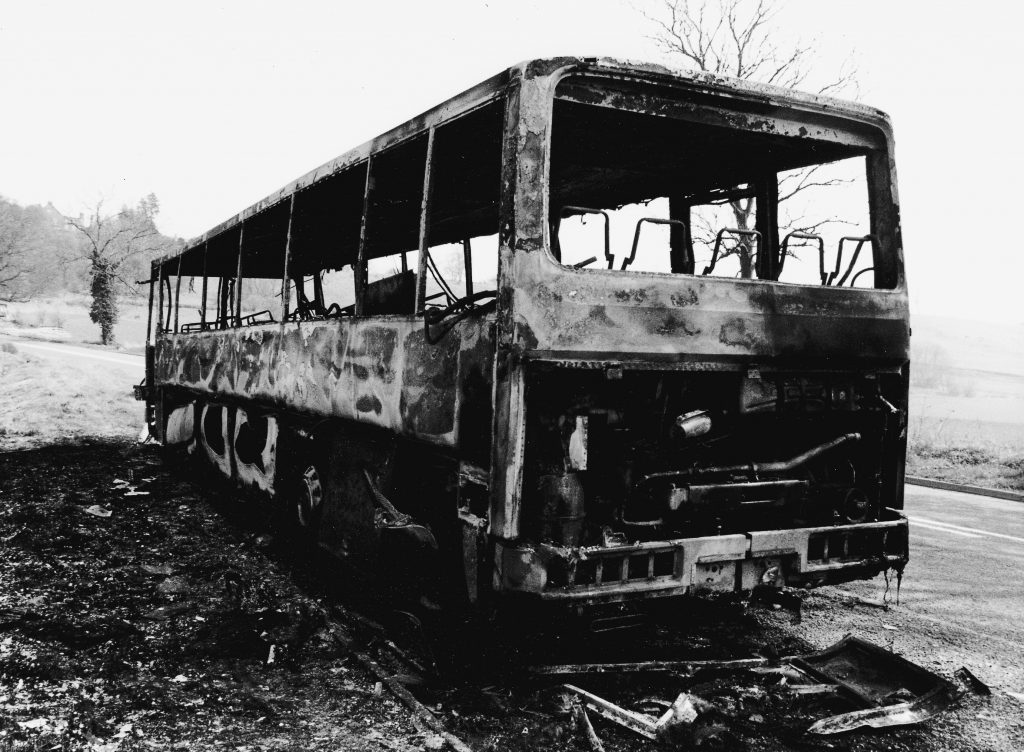
The roof and all the wiring at Hanson Avenue, Shipston on Stour, were severely damaged when a house was hit by lightning.
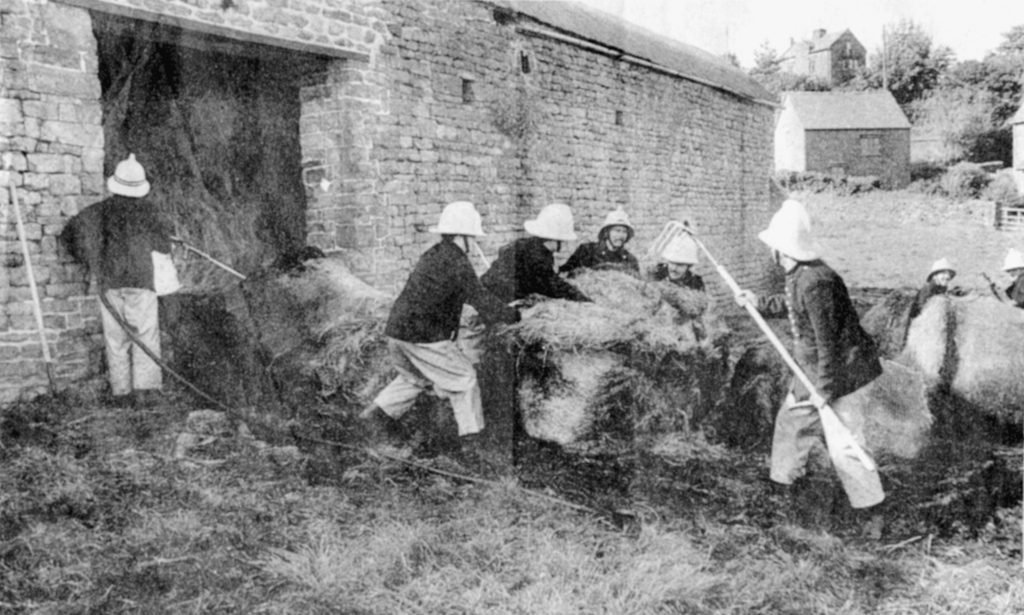
New equipment arrived at the Station in the form of two UHF personal Radios.
The Station had the use of two Bedford Jaguar Pumps this year, registrations OWD 999M and PWD 999M.
1988
The records show a total of eighty-one calls, which included two calls to Alkerton tip, two vehicles and five cars on fire, and one call to the scrapyard at Bloxham, where a large number of cars were on fire requiring three jets and five hose-reels. Two special service calls were recorded, one of which was to a spillage of congealed vegetable oil down the whole length of Sunrising Hill, which was removed after three and a half hours with the use of hose-reels. The other call was to rescue a child who had been locked in a flat. There were four Road Traffic Accidents, forty-three false alarms, ten chimney fires, four farm fires, with three barns, and eight house or building fires.
One of the fires was in the Churchill Club, Banbury, and this was the first time the UHF radios were tested to their full potential. There was a serious fire at new apartments at Walton Hall, where eight jets, hose-reels and eight B.A. sets were used. A major exercise, Western Encounter, was held at the Central Ammunition Depot, Kineton. At Epwell, three sows and ten piglets were killed in a farm fire.
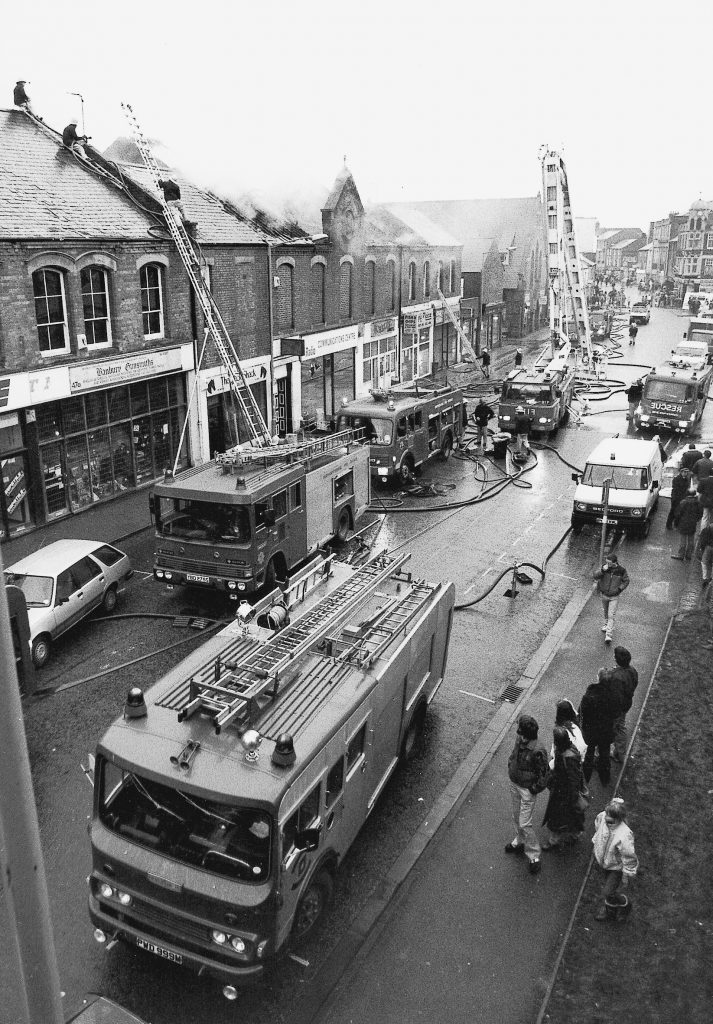
The Bedford Jag was replaced with a CSV Pump registered no. CWK 997T.
1989
Seventy-one calls were recorded; four Road Traffic Accidents, nine farm fires (three in barns), ten chimney fires, thirty false alarms, many of which were at C.A.D. Kineton, and eighteen house or building fires.
At the offices of Tom Pettifer Construction in Shipston on Stour, ten B.A. sets, two jets and hose-reels were used to locate and extinguish the fire.
There was a fire during the year in the Catholic Church at Brailes, and in another incident, at Poolfields in Kineton, about 500 fish were rescued when a fire in the building in which they were stored was extinguished.
On 5 July, due to an equipment fault at fire control, calls came from The West Midlands Fire Service control room in Birmingham. The Sub Officer had to spend the night in the Station to receive fire calls. This had not happened since the Second World War.
The Pump was replaced with a CSV Pump, registered OWK 999W.

New equipment during the year included Peda Cutters and a Tirfor Winch to help at Road Traffic Accidents.
At the end of the year the CSV Pump was replaced with a Bedford CFE Pump, registered LVP 860X.
1990
Ninety-two calls were recorded, including a caravan fire, a vehicle fire, two car fires, two Road Traffic Accidents, three special service calls including one to Warmington Hill, where a lorry was leaking caustic soda, thirty-seven false alarms, seven chimney fires, seventeen farm fires, eight of them in barns, two stand-by duty calls and twenty house or building fires.
On Christmas Day from 10.16am until 12.40pm the crew attended special service calls at Village Farm, Gaydon and then went to Hall Farm, Little Kineton. There was a very strong wind and roofs were lifting off some houses. An old mud-walled barn was destroyed, in addition to much of the orchard.
At a barn fire at Kirby Farm, Whatcote, the only available water was in a pond about a mile away from the barn. Water was pumped from the pond into a dry ditch nearby, from where it ran down to the farm and was pumped back on to the Fire.
The most serious fire during the year was at Lloyds warehouse at Mancetter, near Atherstone, where eighteen jets were used.
This was the final year during which fire drills were held at the Royal Observer Corps’ underground posts at Edgehill and Long Compton.
1991
There were fifty-one calls during the year, including a car fire, a coach fire, three Road Traffic Accidents, one ‘suspect package’ bomb alert at C.A.D. Kineton, three special service calls, seventeen false alarms, eleven farm fires, four of which were in barns, ten chimney fires, and four house or building fires.
The special service calls were unusually interesting. One was to a horse with its legs trapped in a metal gate at Cherington, the horse being released with the aid of the Epco, another to deal with a spillage of seeds in Shipston on Stour, and the third to a house in Radway to rescue from a roof void a man with an injured back. A stretcher was used.
In a Dutch Barn fire at Yarn Hill Farm, Epwell, forty sheep and twelve large pigs were killed, the pigs being shot by the farmer because they were so badly burned. Ten days later, fifty sheep and nine calves were rescued from a fire in a Dutch Barn at Vine House Farm, Whatcote.
The crew attended a fire of two large straw ricks at Barford Farm, South Newington. Each rick was of some 1000 tons. A barn full of hay was saved.
At an Old Peoples’ Home at Low Furlong, Shipston on Stour, six people were rescued by the crews from Tysoe and Shipston working in dense black smoke, from a fire in one of the bedrooms. Six men wore B.A.sets, and one jet and hose-reel was used. Two dogs were rescued from a house fire in Arlescote
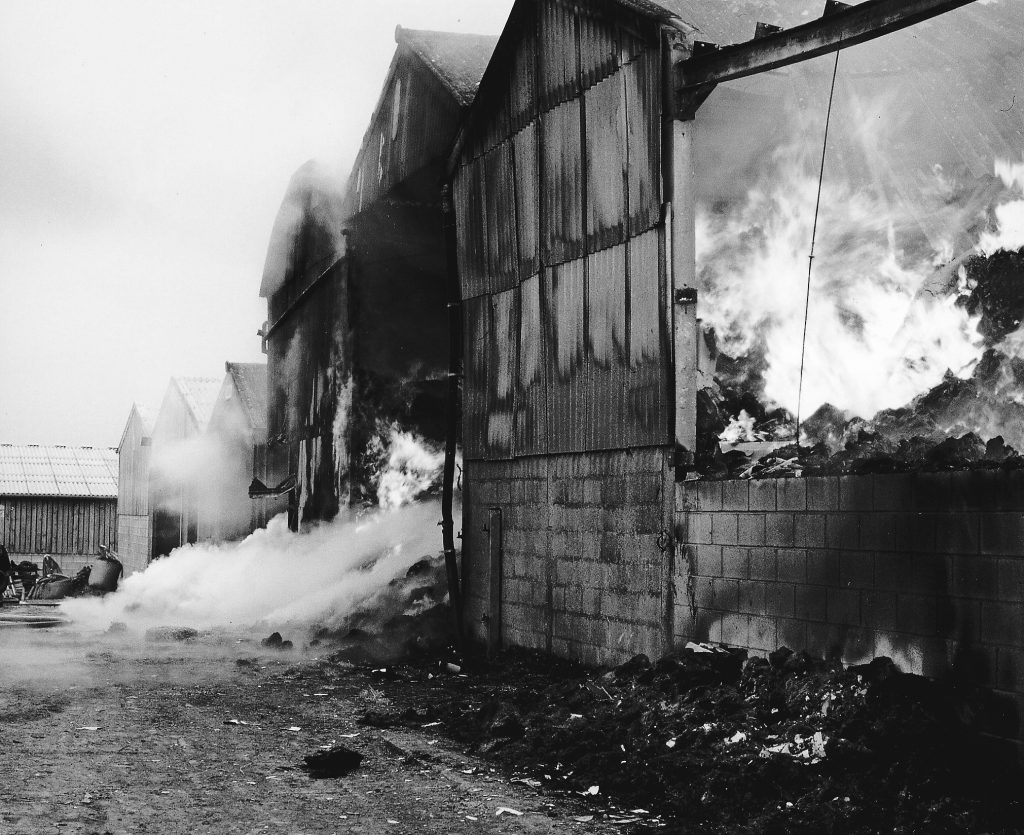
The station, along with Fenny Compton, was once again under threat of closure by the Conservative County Council. The station was ‘reprieved’ only because Councillor John Findon voted with Labour to keep the two stations.
The Marquis of Northampton offered to contribute towards the cost of the two stations to help keep them open.

Sub Officer Wyles received his Long Service and Good Conduct Medal from H.R.H. The Princess Royal G.C.V.O. (more than two years late).
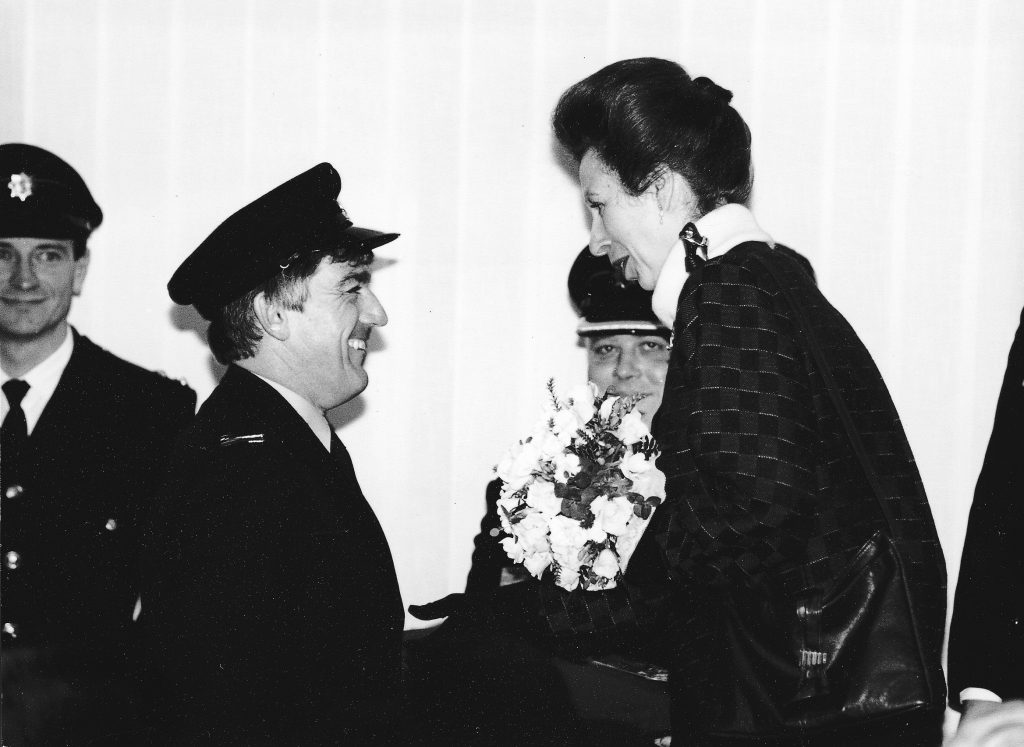
During the year a new policy was implemented, whereby only one pump was sent to a fire call. This produced a reduction in the responses by the Station.
1992
There were thirty-one calls during the year, including two vehicles on fire (one of these involved an articulated lorry on the M40, which was burning well, with oxygen cylinders exploding out of the side of the lorry across the carriageways), three car fires, two Road Traffic Accidents, one special service call to a chemical spillage and fire at Kineton, five false alarms (the number of false alarms was greatly reduced since the Tysoe Station was no longer named as the ‘second crew’ for calls to Shipston on Stour and Kineton because other stations were deemed to be closer), two farm fires, seven chimney fires, one stand-by duty, six calls to flooding during May and September, and two house or building fires.
In flooding at Oxhill Manor Grounds a flock of sheep were in trouble in some four feet of water. The Sub Officer advised Fireman Gardiner to take care and to watch out for the actual stream, which was somewhere nearby under the floods, promptly disappearing up to his neck down into the stream. Fireman Gardiner rescued the Sub Officer before the crew were able to recover twenty live but very wet and heavy sheep.
The most serious fire during the year was at Altovar, in Station Road, Banbury. This was an old warehouse, and sixteen pumps and other appliances were used.
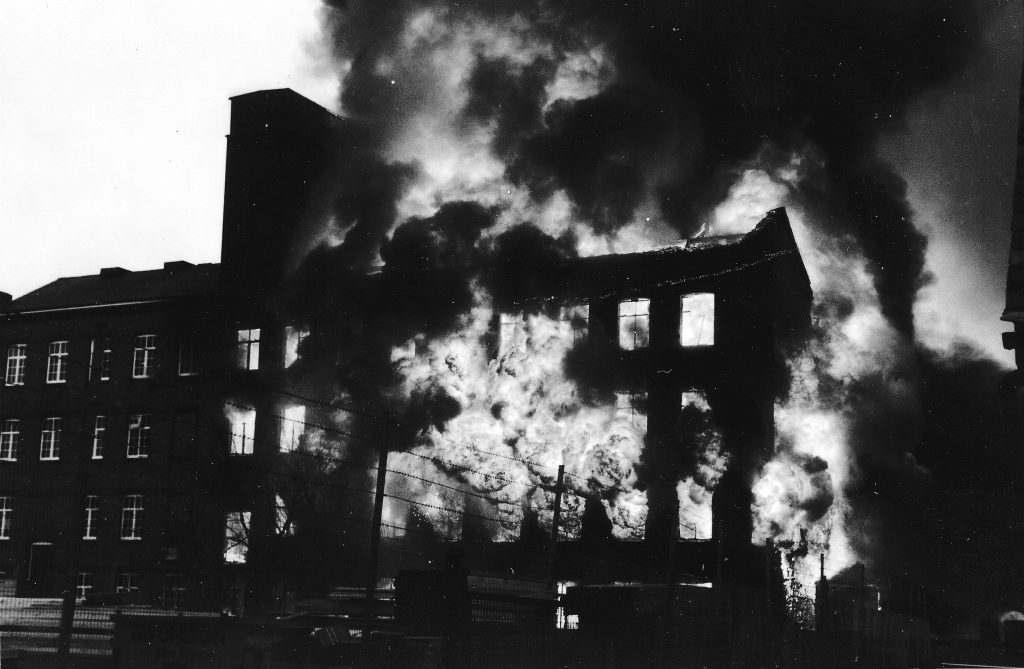
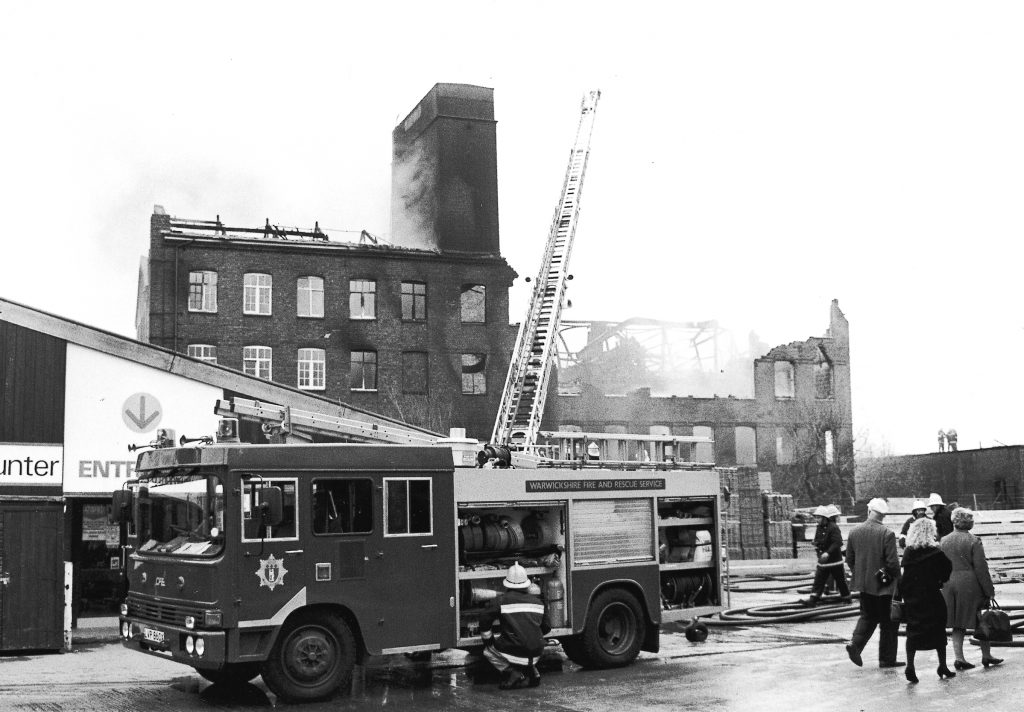
At the end of the year the CFE Pump was replaced by a Bedford, registered no. C316 WRW.
The Station was once again under consideration for closure, just three months after the last reprieve, but no further action was taken.
1993
Only twenty-seven calls were recorded during the year, including one stand-by duty, a Road Traffic Accident, a car fire, two false alarms, two special service calls, one of which was to a petrol bomb in a two gallon container which had exploded in Queen Street, Bloxham, and one to an oil spillage down Sunrising Hill, four farm fires (one of them in a grain dryer), eight chimney fires and eight house or building fires. One of these involved a thatched roof at Stourton.
It is perhaps interesting to note that the Tysoe Station was not alerted to attend a house fire in Oxhill, just two miles away, until pumps from Shipston on Stour and Kineton were already at the fire. This was in spite of the fact that the house owner advised when she made her 999 call that the nearest station was Tysoe.
The most serious fire during the year was at Chesford Grange Hotel near Kenilworth, where ten pumps, one H.P. and eighteen B.A. sets were used.
The Station was yet again, with Fenny Compton, a subject for closure by the newly elected Conservative County Council, but was again reprieved.
During March a reception was held in the Station after the christening in Tysoe church of Sub Officer Wyles’ triplets, Rachel, Mark and Lee. This is believed to be the only occasion when babies’ nappies were changed on the office desk.
Leading Fireman K Oliver received his Long Service and Good Conduct Medal from the Lord Lieutenant of Warwickshire.
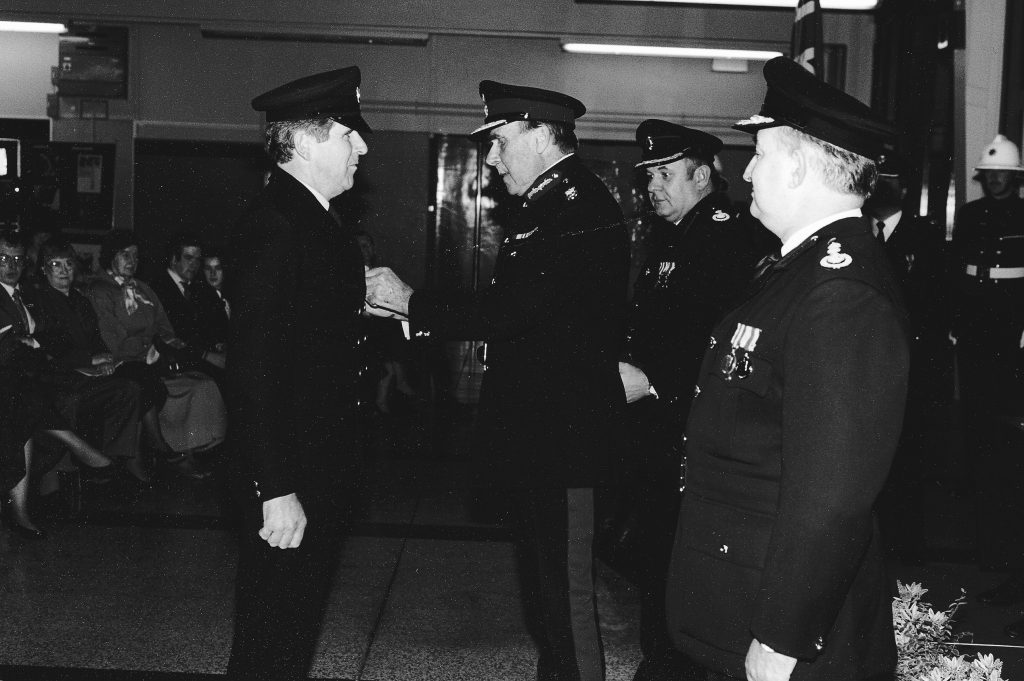
1994
Forty-one calls are recorded for the year, including a vehicle fire, a car fire, three Road Traffic Accidents, four farm fires, six chimney fires, eight house or building fires, five stand-by duty calls, eleven false alarms and an aircraft crash. One of the calls involved a home call to a pensioner with a personal alarm, which was designed to ring in the fire service control room when pressed whilst around the neck of the wearer.
A pensioner died in a bungalow fire in Old Road, Shipston on Stour. She was found just inside her kitchen, only a short way from the door. There was a small fire in the letterbox of the village post office and another fire in the roof of the old Council Offices in Shipston on Stour, which was attended by crews from Tysoe, Shipston on Stour and Stratford-upon-Avon.
A light aircraft, an ex-Russian trainer, crashed at Lighthorne, and the pilot was unfortunately killed. The passenger was rescued from the wreckage, but died later in hospital.
Leading Fireman Brain retired at the end of the year and Fireman Sewell was promoted to Leading Fireman.
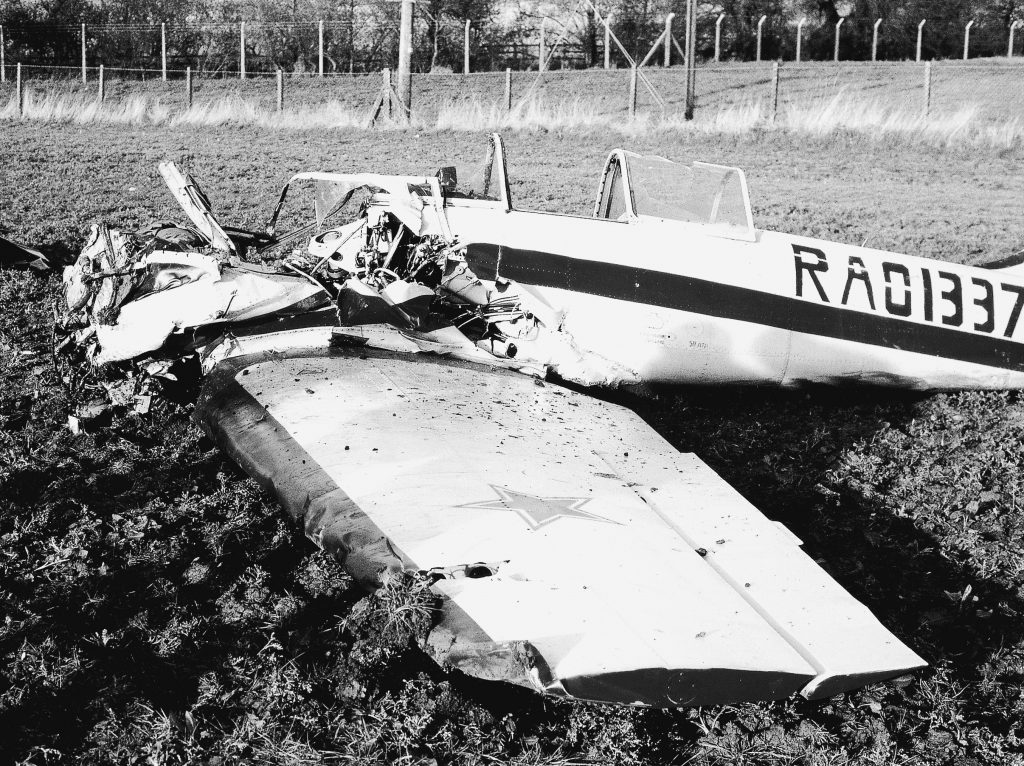
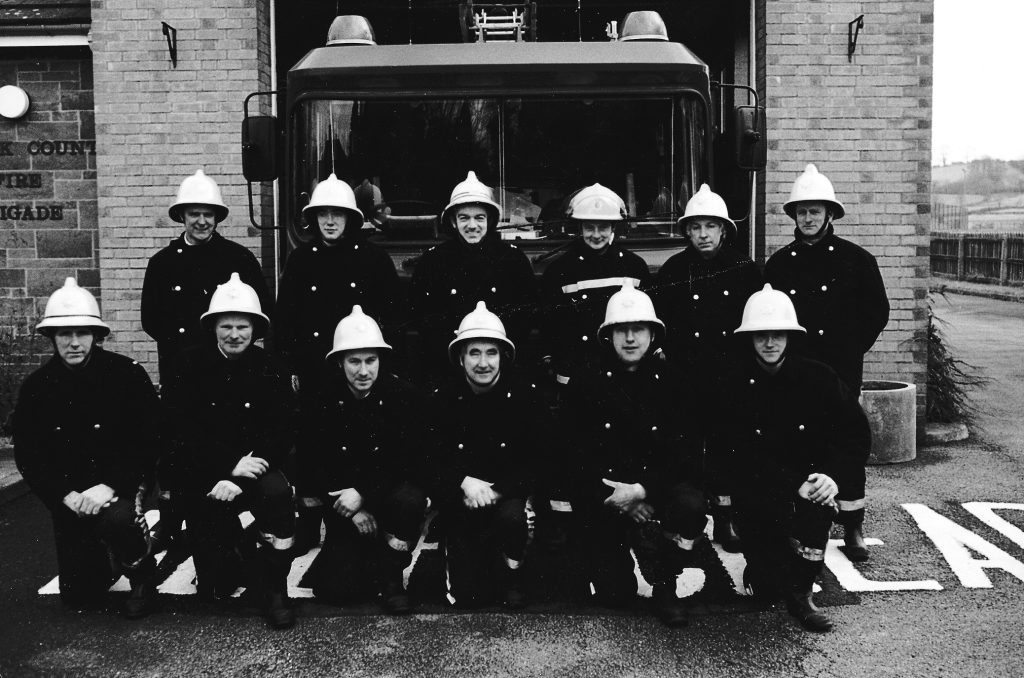
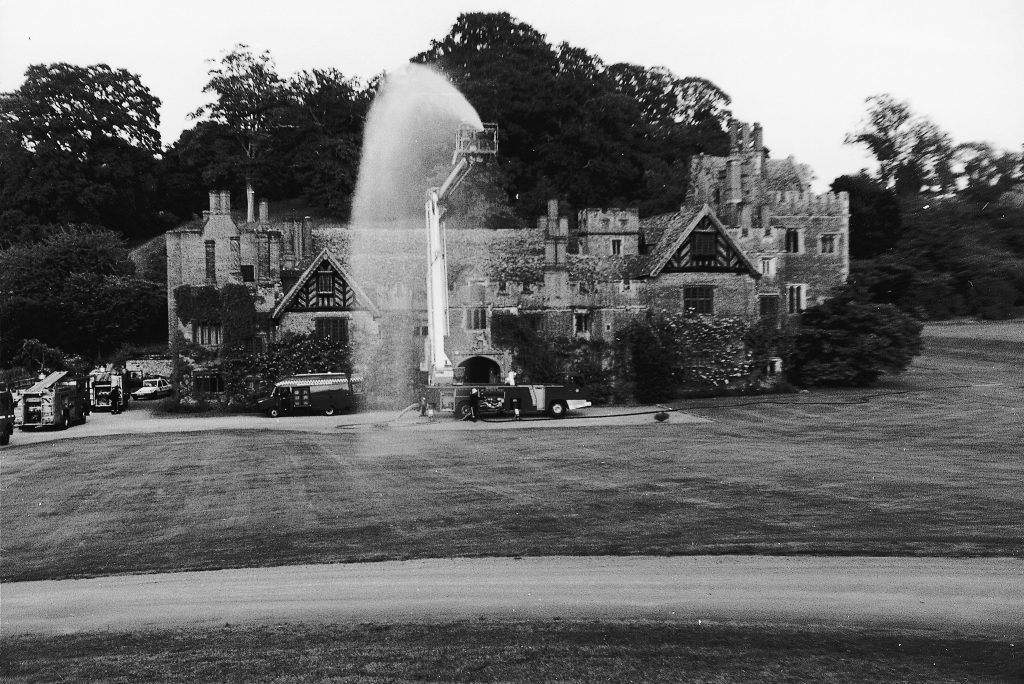
1995
Eighty-six calls were recorded, including a car and a vehicle fire, fires at each of the two refuse tips at Alkerton and at Newbold on Avon, near Rugby, two special service calls, six chimney fires, sixteen false alarms, seventeen stand-by duty calls, twenty-seven farm fires, including three barns, fields and hedgerows, and fourteen house or building fires.
At Old Milverton Road, Blackdown, Warwick, five Pumps were controlling a fire. The crew was told to leave this fire, allowing it to burn out when it had travelled into and past a wood near the road, to put away the equipment and go to a fire in fields at Leamington Hastings.
Most of these calls were to the areas around Warwick, Leamington, Nuneaton, Coleshill, Bedworth, Atherstone, Rugby and Willenhall.
One of the special service calls was to a dog, which was stuck down a rabbit hole near the Castle Inn at Edgehill. The dog, of course, found its own way out. Another special service call was to a Water Buffalo, stuck in a milking parlour at Upper Nineveh Farm, Whatcote. The beast was removed using slings but had died before the arrival of the crew.
Ten B.A. sets, three jets and hose-reels were used at a fire in a factory at Brookhampton Lane, Kineton. Another fire involved wood processing buildings at Nuneaton.
A fire was reported in a bedroom on the second floor at Kirby Farm, Whatcote, where smoke filled the rest of the house.
Oxygen and Acetylene cylinders had fallen from the third floor of new buildings at the Rover Test Centre at Gaydon, damaging the valves and leaking. A jet was aimed from behind cover, and then the thermal imaging camera was used to find the hot spots, which were then successfully moved.
There was a boiler fire at 1 Fighting Close, Kineton. Fire Control at Leamington were unable to call out the Kineton crew, but the Tysoe crew were there in less than twenty minutes. By this time, however, the fire had really taken hold, and flames were coming out of the bedroom windows and through the roof. Six B.A. sets, three hose-reels and a jet were used to control the fire. This situation demonstrated just how quickly fire will spread, and burn out of control, if there is no Fire Service close at hand.
Leading Fireman Oliver retired and Fireman Gardiner was promoted to Leading Fireman during the year.
In October the crew numbers were increased by the addition of the local vicar, the Rev. David Knight, who thus became the second vicar to serve in the Tysoe Brigade.
1996
There were eighty-two calls recorded, including one vehicle and two cars on fire, a special service call to a diesel spillage at Pillerton Priors, and four home alarms (all to the same house in Tysoe). On one occasion the pensioner was wedged between the bed and the bedroom door and on an another call was seated on the toilet. Whether the Sub Officer or the pensioner was most surprised is not recorded. Also recorded were six Road Traffic Accidents, eight stand-by duty calls, twenty-one false alarms, ten chimney fires, eighteen farm fires (with two barns, five rick fires and some standing corn fields), and eleven house or building fires.
In one of the traffic accidents, near Temple Pool gates on the A422, the passenger’s car seat had been crushed around her, confining her legs to a space of just a few inches. She was eventually released, after a great deal of very careful effort, by using the Clan Lukus rams and spreading and cutting jaws.
One of the false alarm calls indicated that a light aircraft had crashed in the Tysoe area. Pumps were sent out from Tysoe, Shipston on Stour, Kineton, Stratford-upon-Avon and Leamington, but no plane was found.
In a fire at Tysoe Manor, the 13.5 metre ladder was just long enough to reach the top of the chimney, and in a large farm fire at Barford St Michael, more than forty acres of fields were burned.
Two of the building fires involved thatched-roofed properties, one being The Old Red Lion Inn at Hornton, where, because the water hydrants in the village were so poor, the pumps had to go to the top of Sunrising Hill and to the hydrant at Alkerton Barn to fill up with water and return to the fire.
At Pinfold Cottage, Kineton, eight pumps and four special appliances were used. The Tysoe pump was the first to arrive, as the Kineton crew had difficulties with their personal alerters and Pump. The thatch was burning on the inside of the roof along three of the cottages, and six jets, stage two B.A. sets and ladders were used.
A major fire occurred at Elizabeth the Chef in Leamington Spa, and another at Lodge Farm, Kineton. The last serious house fire during the year was at Sibford Gower, in a cottage with a roof tiled with cedar wood. The Tysoe crew removed most of the burning tiles, provoking the observation from an Oxfordshire officer that he had ‘rarely seen a roof removed faster’. He wasn’t to know that the crew included several builders.
One irony was that, after the many false alarms received from Wroxton College over the years, a ‘genuine’ fire took place there, fortunately only a small one in a bedroom, caused by a hair drier, which produced very heavy smoke.
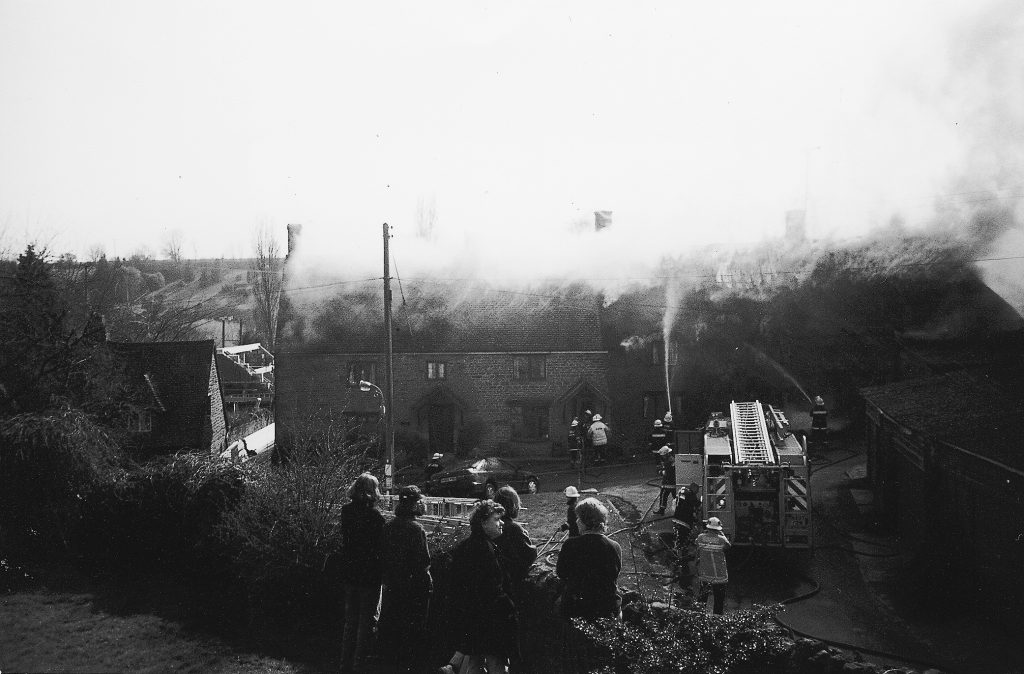

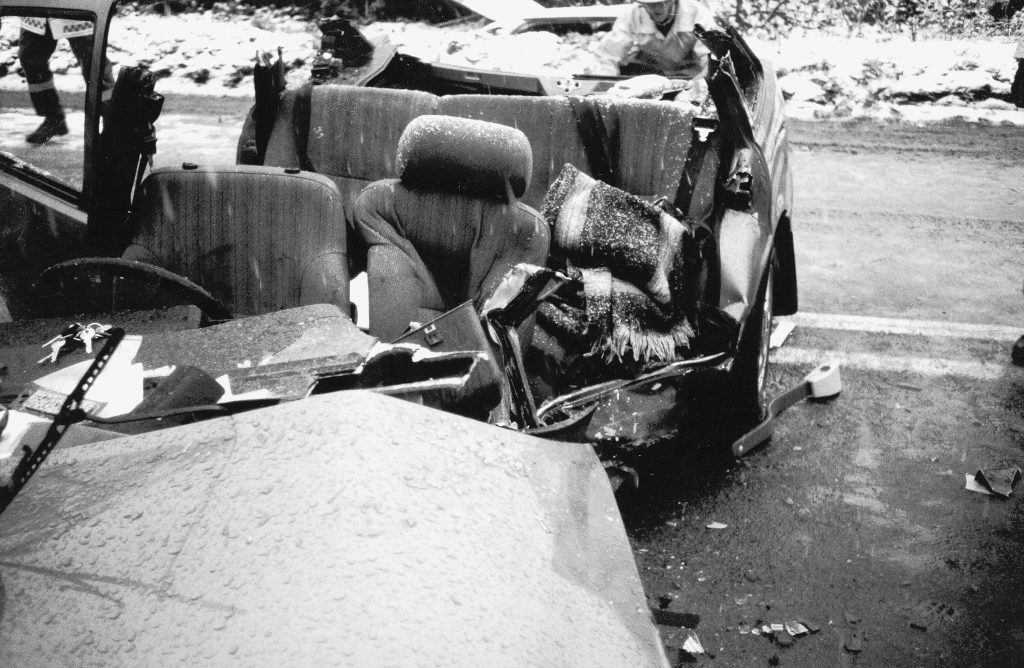
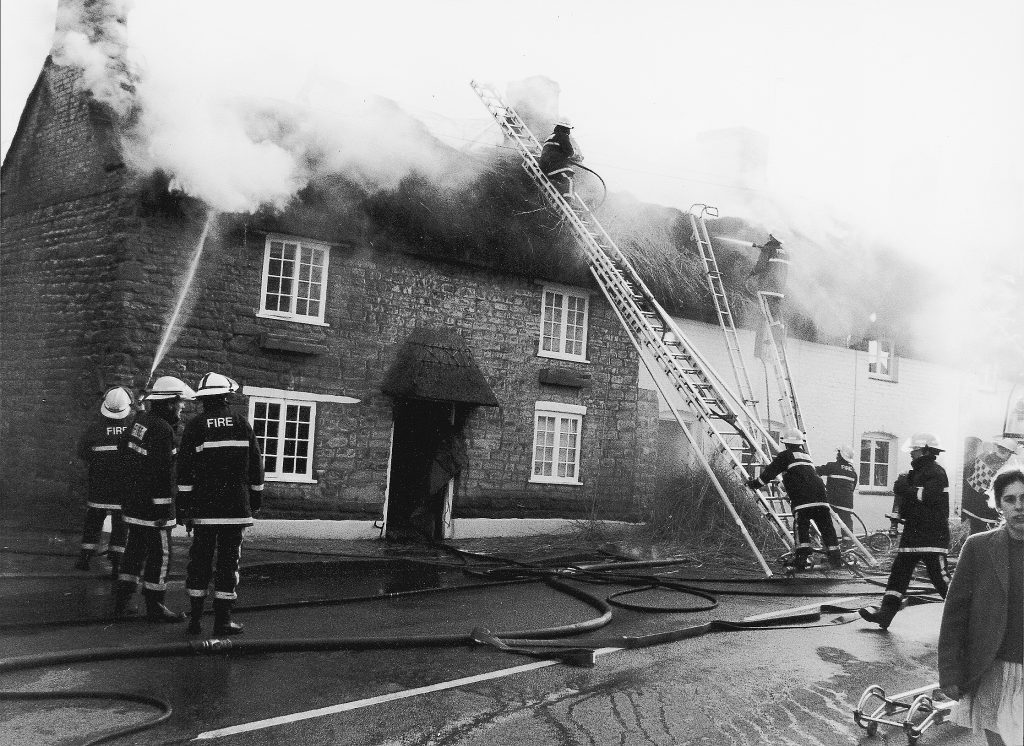
On 28 September a centenary celebration of the Tysoe Brigade was held on the Station. This was more than a year early, as the Station was wrongly advised that the first meeting had taken place in July 1896, whereas it was in fact on 20 July 1897 (see page 2 of this book). Councillor J Findon unveiled a ceremonial brass plaque and Earl Compton planted a commemorative oak tree in the lawn at the side of the drill yard. There was also a display of old and new appliances and equipment.
At the end of the year the Bedford Pump was replaced by a Dennis Pump registered no. D783 GHP.
The B.A. sets were updated with sonic communications during the Year.
At Hook Norton Fire Service Centenary Event, the Tysoe crew won the hose running competition, competing in a series of heats against crews from Oxfordshire and Northamptonshire, and from Fox FM and The Bear radio stations. The following year a mixed team containing some members of the Tysoe crew was again successful, winning a barrel of beer.


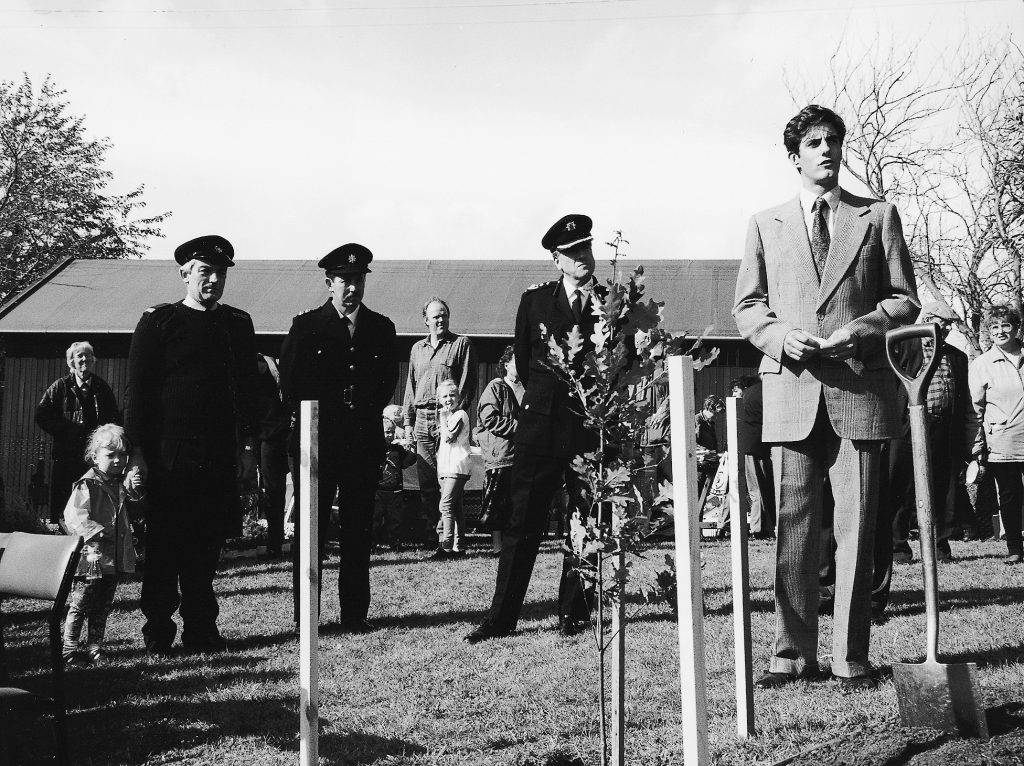


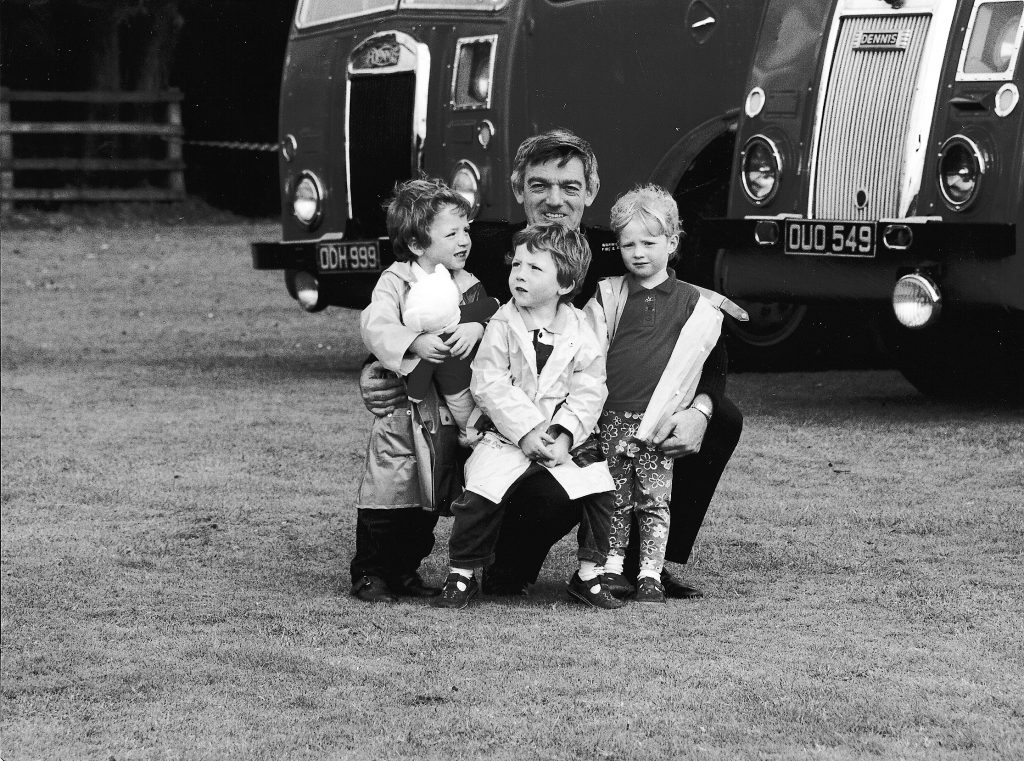

1997
A record number of calls were recorded during the year, totalling one hundred and two, including a tip fire, a call to flooding at the Tesco Store in Stratford-upon-Avon, two home alarms, three cars and one lorry fire, a tree fire, an aircraft crash and six Road Traffic Accidents, two of which involved articulated lorries on Sunrising Hill, the second lorry having covered the road in thirty-eight tons of fresh yoghurt!
There were also four farm fires, nine chimney fires, eighteen standby duty calls, thirty-seven false alarms, thirteen house or building fires and five special service calls. One of these was to a slurry pit at Lower Farm, Whatcote, where four cows were rescued from 8ft deep slurry by using a tractor’s hydraulics and lines. The animals were then given a very good wash down.
At the Kennels, Upper Tysoe, a cat had been stuck in a chimney for thirteen days, having climbed up one chimney and then down into another. The owner had been searching without success for the cat until he heard it within the bedroom wall flue. A hole was cut into the outside wall and the cat was retrieved alive, reasonably well and caked with black soot.
An unusual incident occurred at the Cottage Bakery in Tysoe, where a lorry collided with an R.S.J. which was holding up the roof. The lorry was removed after the roof had been supported by the insertion of props.
At the new building site in Jeffs Close, Tysoe, the old barn, which had been used to store the ladders and hooks back in the 1980s, collapsed onto a workman, who was pulled out by his mates suffering only shock and cuts.
There was a serious fire at a new sports complex at Dorsington Manor, and a fire, mainly of wooden pallets, at industrial units in Overthorpe Road, Banbury, where eighteen appliances and eight jets and ground monitors were used.
A house in Whitchurch suffered extensive damage following a fire. A water relay was operated from the river, using five pumps. At Alcan Laboratories in Banbury, fifteen pumps with ten jets and ground monitors and ten B.A. sets were used.
The final call of the year was to Alveston Kitchens, Leamington Spa, where sixteen B.A. sets were used, together with three jets, hose-reels and a monitor from the H.P.
The crew responded to a call to Shenington Air Field, where a Cessna light aircraft had crashed. Ten people were reported to be trapped in the aircraft but all escaped without serious injury, though badly shaken. A hose-reel and foam jet were used, as there was a fuel leak from the wing of the aircraft.
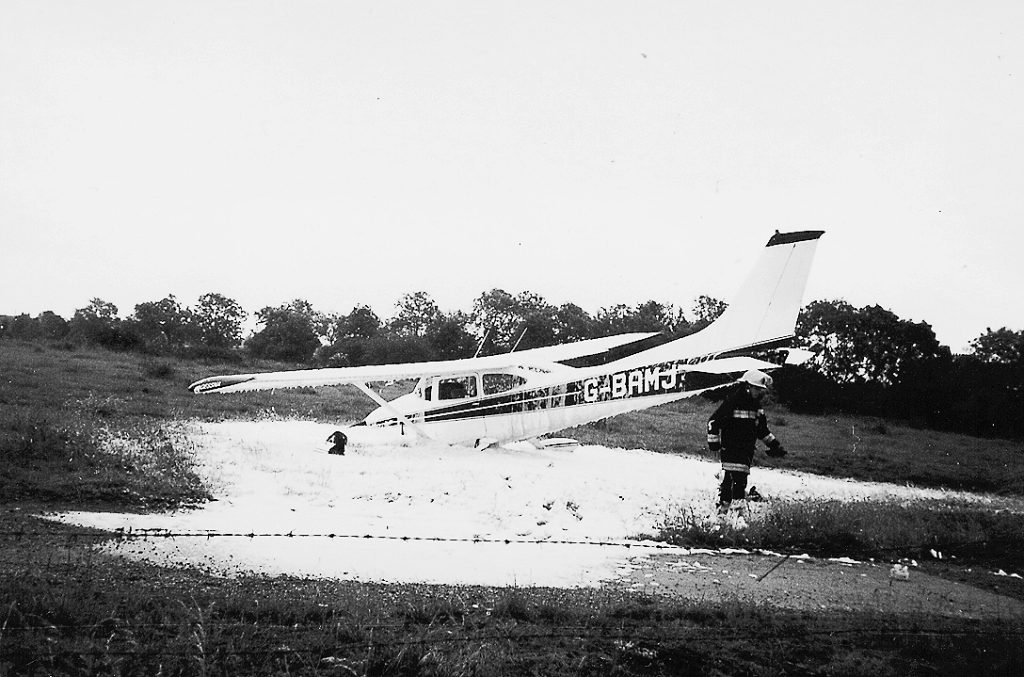
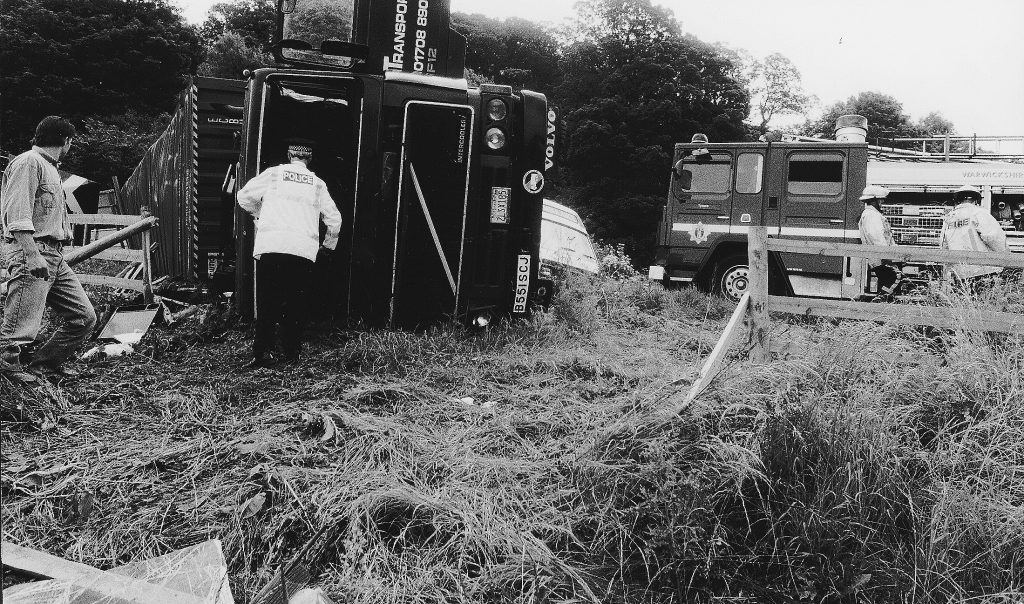
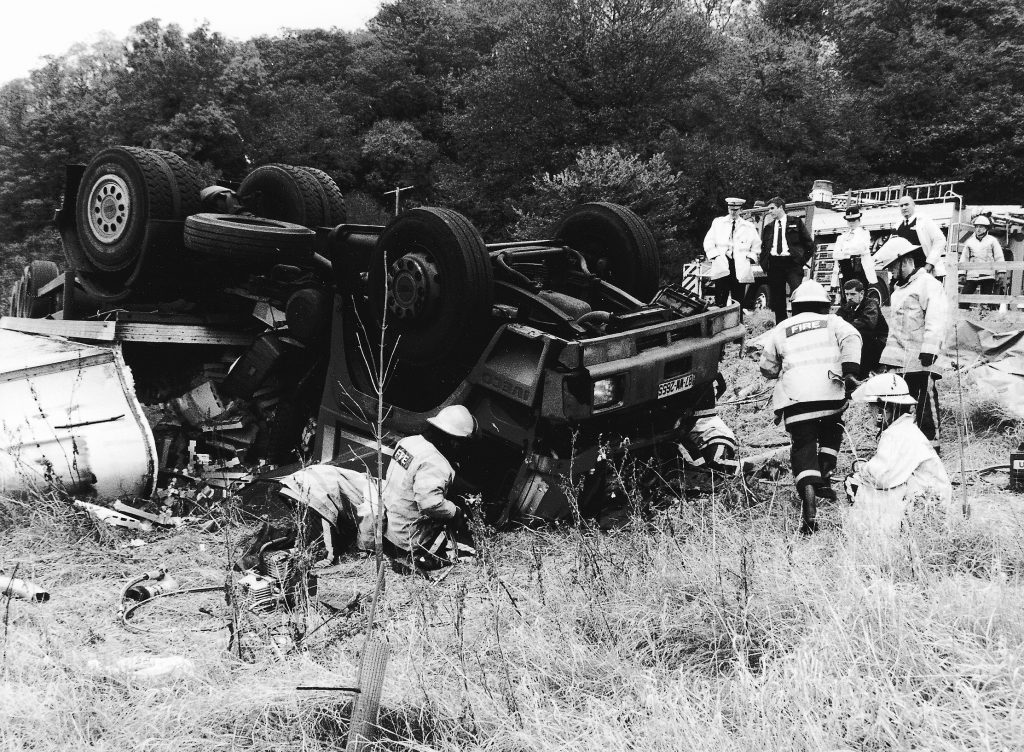
The two fire stations at Tysoe and Fenny Compton were yet again targets for closure by the new Labour County Council, a new station being planned for Wellesborne with part of the cost coming from the proposed sale of the land from the Tysoe site. Kineton Station was also recommended for closure, after the decision had been taken to close Tysoe, but Fenny Compton Station was reprieved.
Once again there was overwhelming support from the local area to keep Tysoe Station open, but most of the Labour County Councillors were from North Warwickshire, and voted at a meeting on 3 December to close the Station. Somewhat ironically, on the same day, workmen were observed laying a new tarmac driveway to the outside of the Station at a cost of more than £1,500.
During the year, the firemen supplied and fitted domestic smoke detectors (two per home) into most of the houses in Tysoe.
1998
There were forty-nine calls recorded up to 19 May, when the Station closed and the Pump was driven away. These were made up of three false alarms, a farm fire, three chimney fires, the last one being at Church Farm, Oxhill, and five cars on fire. There were two special service calls, one of which was to a child locked in a toilet at Edgehill, where the door stop was removed in order to gain access and cut the bolt, and the other to remove a tree which was blocking the A422 road at Upton. Also recorded were eleven stand-by duty calls, seven house or building fires, and seventeen calls to action during the extensive flooding which occurred over Easter.
In a house fire at Oxway Close, Shipston on Stour, a lady and her dog died. Four B.A. sets and a jet were used. The Shipston crew was not available at the time, and the fire had been burning for more than an hour. There was a serious fire in a bedroom at Edgehill Farm, Edgehill. A kitchen fire in Middleton Close, Tysoe was extinguished with the use of two B.A. sets and a hose-reel. The final house fire in Tysoe to be attended by the Tysoe crew was at 2 Cornerways, on the Shipston Road on 12 March, where a hose-reel and a dry powder extinguisher were used to put out a fire in a boiler flue and wooden partition on the rear roof.
The crew faced one of its greatest challenges during the flooding over Easter, and it is worth detailing the activity.
The Fire and Rescue Service received the first flood call at 08.11 to Farthings, Lower Tysoe, where an officer attended and the crew was called from Tysoe at 08.30. The main Pump and portable Pump were used until 12.25 when more small pumps and sandbags were put into use in vain efforts to deal with the still rising water level. The crew went to Greenacre Farm, Lower Tysoe from 12.26 until 12.45, and then on to Humber Barn, Lower Tysoe between 12.46 and 13.08. The water level was still rising and there was nowhere to pump it to, as the heavy rain continued.
The next call was to Welchman’s Place, Tysoe, where water was lying everywhere and still rising. The crew attended from 13.10 until 13.30. The main village street from Avon Avenue down to the Peacock Inn, then down Saddledon Street and on to the School, was like a river, the water completely covering the road and flowing at a depth of some three inches. Conditions worsened throughout the day. From 13.31 until 14.28 the crew was on stand-by duty at Tysoe Fire Station. There was a call to a fire at Bradley Arcade, Banbury from 14.29 until 14.40, after which stand-by duty at Tysoe was resumed until 14.54. The crew then went to floods at Radway until 15.10. Stone steps into one cottage were removed to allow the water to run out but it was still entering the back of the cottage through the walls and air vents. The rain was still torrential.
The next call was to Sutton under Brailes at 15.11, where a cellar was filled to its roof with water. The portable pump was used inside the main hallway of the house, with two hose lines leading out to the road. Since the pump was being operated inside the house, exhaust gases had to be continually extracted. The continuous stream of water, which was running down from the hills, was diverted by the crew to bypass the side of the house. This was followed by a call at 16.51 to a farm in Brailes, but a crew from Shipston had been there three hours earlier and removed the water. The crew then went to attend more flooding in Brailes, this time part way up Holloway Hill, where, from 17.05 until 17.50, it was necessary to wade through water which was three feet deep and very cold. Then began a complex route through part-flooded roads to locate a filling station for diesel. The Tender was unable to go to Shipston on Stour as the water was too deep, but spent an hour getting across to Pillerton Priors, where filling-up was completed at 18.50, ready for the next action of the day.
The next call was to a house in Oxhill, where furniture and a carpet were removed, but water was still coming through the stone walls into the house. From here, at 19.10, the crew went to Oxhill Road, Tysoe where the drain covers were removed to allow surface water to run away, as the rain had at last stopped. It was then back to stand-by duty at Tysoe Station from 19.25 until 20.10, with a little time to change into dry kit and have a well-earned cup of tea.
A recall at 20.10 to Welchman’s Place took nine minutes, but the water level was going down, so the crew was then sent to stand-by duty at Fenny Compton Station from 20.19, until recalled by radio to go to Peacock Court, Wellesbourne at 20.25. This involved more than two hours of operations in extremely cold water four feet deep, with the Kineton crew, pushing boats along Chapel Street into Peacock Court in order to rescue nineteen people and a dog, then returning to dry land at the end of Chapel Street, before rescuing three more people from Bridge Street. One member of the Kineton crew passed out due to the cold, and was taken into a house to warm up, and the Tysoe Sub Officer was given a cup of hot soup in a house in Chapel Street, but spilled most of it on the carpet because his hands were shaking so much with the cold.
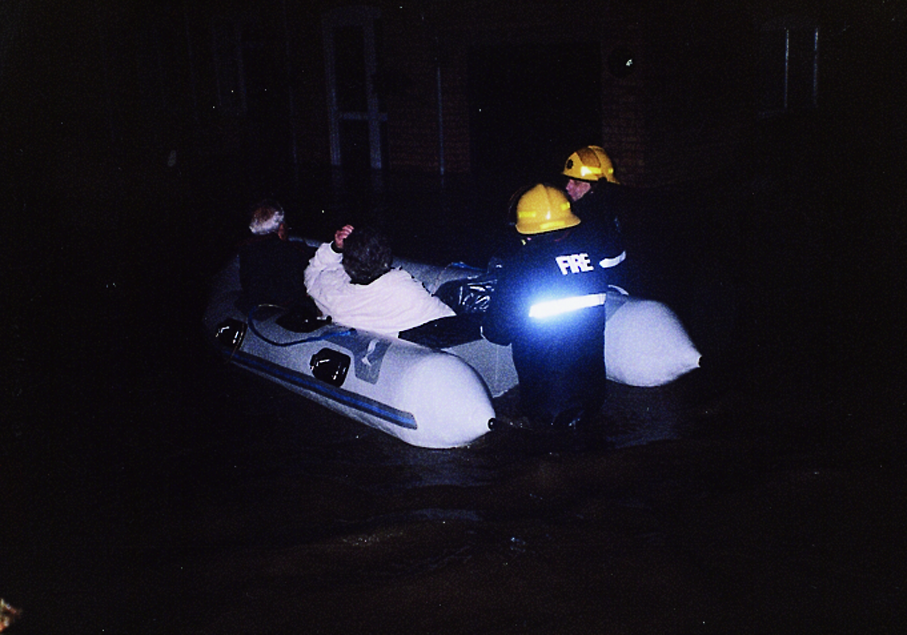
The crew had by this time been out for fourteen hours, since 08.30, with no hot food and they were all soaking wet and freezing cold. A radio call was therefore made to the Control Office to advise that they would not be available to attend further calls until they had all had a hot bath and some hot food. The crew returned home at 22.35.
At 23.21 the crew was called to Warmington to rescue a family of four, who were trapped in their car in flood water, after which, at ten minutes past midnight, the Tender was sent back to stand-by duty at Tysoe Station from 00.10 until 00.44. The men, who had been temporarily warmed by a hot bath, were now once again very cold as the fire tunics, leggings and all their clothes were still soaking wet inside and out.
The next call was to stand-by duty at Stratford Fire Station from 00.44 until 01.05, and then on to Rayford Caravan Park, Tiddington Road, Stratford upon Avon from 01.05 until 06.15 to help the crew from Brinklow to rescue the Easter weekend holiday-makers from their flooded caravans. The walk from the road to the caravan park was of some 350 metres, and, since it was all under fast-flowing water, the crew members were initially somewhat reluctant, as they had just spent a long time in freezing cold flowing water at Wellesbourne. Activities were, however, shared with colleagues from another crew, and a great many people were still in their flooded caravans with the water level rising fast. The Sub Officer set off with the rest of the crew, wading through the freezing cold water.
About half way across the park, the water having reached waist level and still rising, the crew formed pairs to hold each other up in the strong current. In the park the water was up to shoulder level. A woman and three dogs were ‘walked’ back to the main road through the water by one of the crew as they were in a pair but the fireman was then unable to make the return trip as the current was too powerful.
An old boat was used, and was pushed around the caravan park to rescue the people from the caravans and take them back to the flooded club-house, as this was out of the cold wind. The floor of the club-house was more than three feet above ground level, but the boat was pushed into the snooker room in order to allow those rescued to climb out onto the snooker table. Pushing the boat was a somewhat hair-raising experience, since there were raised footpaths, electric plug-in posts and steel benches all under water and hidden from view. There was no electricity supply available in the club-house, but street lights were still illuminated outside. To keep warm a man suffering with angina, the firemen wrapped him in curtains and some men sat around him all night. There was no way to get back to the road by this time, as the water level inside the club house was now above the table tops, so the Sub Officer sent a message for more fire crews and a large power boat. Eventually a boat arrived and first the caravanners, and then the crews, were transported to ‘dry land’. The boatman confirmed that the current flowing across the field to the road was stronger than the current in the river, and there was no way that a pair of men could walk across it. At the time it was thought that twenty-five people and eleven dogs had been rescued but it was later established that forty people, eleven dogs and a parrot had been rescued from the club-house by the two crews. Both crews, together with those rescued, were sent to the Leisure Centre in Stratford upon Avon to warm through and enjoy some food. (See letter of appreciation below).
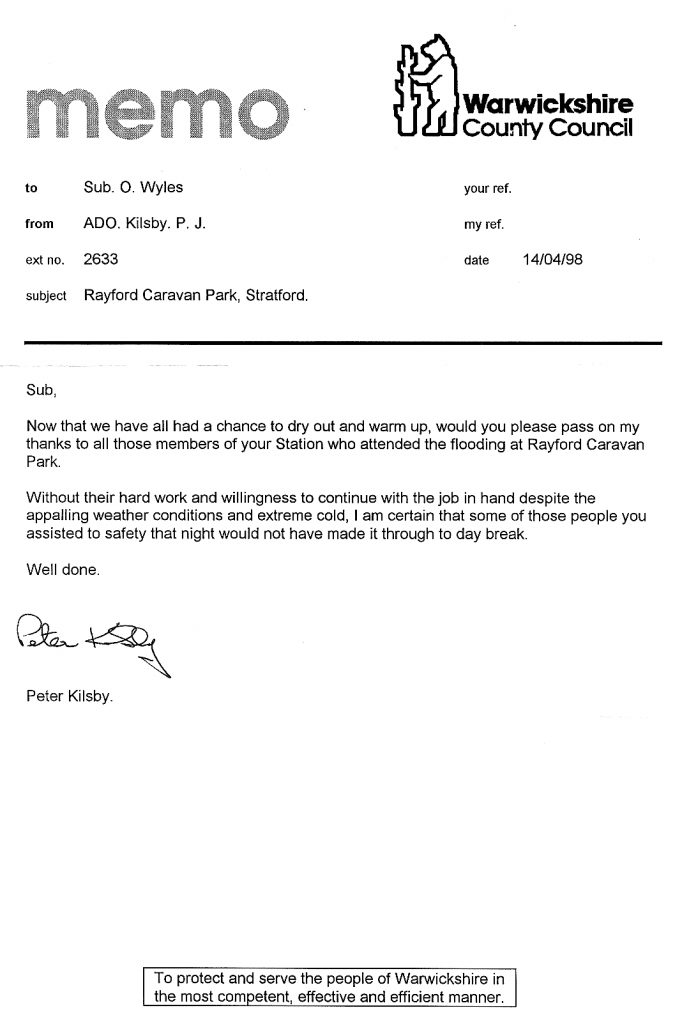
Some of the crew had been out on calls, without hot food and in wet and extremely cold conditions, for more than twenty-two hours. At 09.35 the following morning the crew was called to Leamington Fire Station to give cover duty to the town, and from 10.18 until 18.30 the crew was pumping out the basement of the police station in Hamilton Terrace. In one incident, a woman was sitting on the top of a litter bin in waist high, fast-flowing water, at the junction of The Parade, Victoria Terrace and Dormer Place in Leamington Spa. Fireman D Paxton and his son, Fireman A Paxton, waded out with lines and another crew to rescue her, but the water was flowing too fast. A boat was brought in to help but this capsized, losing its outboard motor. The fireman, wearing a wet suit, was submerged, only to be rescued by Firemen D and A Paxton. The woman was rescued by a boat coming down from Victoria Terrace going with the flow of water.
The firemen had never been colder, in more than thirty years of service, than they were during these two days.
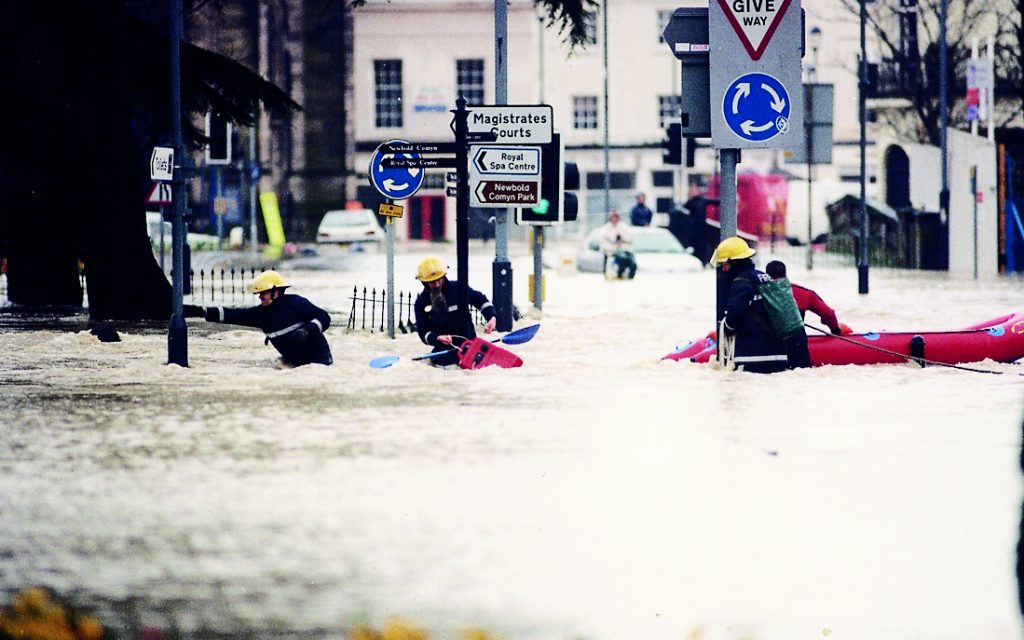
A Presentation Evening was held of awards to more than twenty service personnel for their dedication and duty in the floods of Easter1998, but unfortunately no-one from either Tysoe or Kineton Stations was nominated. From the Tysoe viewpoint at least, this was a great disappointment, and the crew was left wondering whether the situation might have been different if the stations at Tysoe and Kineton had not been shortly to close. There could most certainly have been no cause for any response other than admiration and approval for all of the crews who worked so hard under intolerable conditions during the floods, and the Tysoe and Kineton crews were in the forefront of those operations.

The Tysoe Station was scheduled to close within five weeks, on 19 May 1998. The dedication to duty of the crews in their ongoing support for the people of Warwickshire was shown through to the final call. From 3 December 1997 until 19 May 1998, the crew still attended drill nights to ensure a continual state of readiness for equipment and Pump. Fire drills were not generally undertaken during this period, since morale was low, which was probably inevitable in view of the axe having fallen after the many threats of closure over recent years. The last drill night was held at Compton Wynyates, as it was felt that, because the Brigade had been originally formed and so well supported by the Compton Family, it was fitting that it should end at their home. Photographs were taken of the crew and equipment.
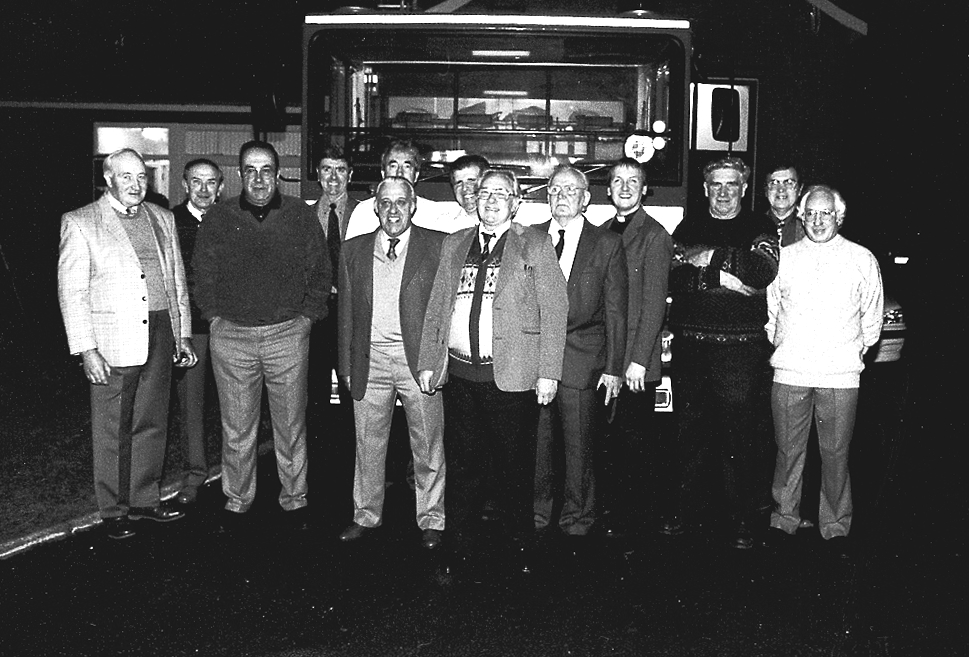
The final call from Tysoe Station was on 15 May 1998 at 15.40, and was to stand-by duty at Stratford upon Avon Fire Station. The crew on that occasion consisted of Sub Officer Wyles, Leading Fireman Sewell, Fireman D Paxton, Fireman Tongue, Fireman Billing and Fireman A Paxton.
At the start of the year a Farewell Evening was held in the Station, for all firemen who had served through the years and for their families and friends. The Station was full, and the numbers present included thirteen retired firemen. Presentations were made in recognition of past services. Fireman D Paxton was given a bronze statue of a fireman, Sub Officer K Wyles an engraved tankard and a bottle of malt whisky, Station Officer M McGreavy an engraved tankard, Mrs M Lomas, who had performed her tasks so well as Station cleaner, an engraved silver plate, and Mrs L Aldrich and Mrs S Baxter each an engraved fireman’s axe in appreciation of all their work over the years in helping to keep the Station open. All of these presentations were from the Station personnel. Each man had also been given a small Warwickshire Fire Service Shield.
19 May 1998
This was a sad day for the village. At 09.00 the Station was closed and the Pump was driven away. There would be no more calls, no more firemen running, cycling or driving with great urgency to the station. An Act of Parliament in 1947 set a maximum time of 20 minutes for a fire crew to arrive at a fire. The closure of Tysoe Fire Station would probably ensure that in future this maximum time would rarely be bettered for any crew arriving to attend a fire or similar emergency within the village. More immediate help for the village had of course been at hand for more than one hundred years from its local Station and crew.
Some might justifiably doubt the value of progress over the fifty-one years since the Act specified this ‘twenty minutes’ period of time!
By seven o’clock in the evening, the main street was filling up with angry and disbelieving villagers. There was, in fact, a crowd of some three hundred people outside the Station. The Pump had been driven back into the station for the closing ceremony.
A flagpole had been erected on the lawn outside the Station office, and the Brigade flag was to be lowered to mark the end of more than 101 years of service by the Tysoe Brigade.
The Marquess of Northampton and Earl Compton were invited to the ceremony, as their family had been instrumental in the original formation of the Brigade and had always given such valuable support to the Station and crew throughout the years. The crew felt that the Marquess, rather than the County Fire Officer, should lower the flag. The church bells were rung throughout the ceremony and at the end they were tolled as for a funeral, 101 times, one for each year of the existence of the Tysoe Brigade


The Marquess lowered the Brigade Standard and, describing the closure as a tragic occasion, expressed the hope that those who had sanctioned the closure would realise how much damage this had done to the village, and would be aware of the potential delays which their action could produce, in the efforts of future fire crews, from further afield, to attend fires in the district.
The flag was folded and the Marquess handed it to the County Fire Officer, who then asked Sub Officer Wyles to step forward and receive it. This produced a great deal of heckling from the watching crowd, some of whom encouraged Sub Officer Wyles to reject the gesture, with other rather more graphic suggestions as to what should be done. Sub Officer Wyles met the County Fire Officer half way and accepted the flag. The crew was dismissed, and the Pump driven from The Station for the last time.
The Brigade was no more. The Station was empty.
Whilst sharing a farewell drink, the crew presented to the Marquess a photograph of the last Tysoe Crew on the final drill night at Compton Wynyates, as a token of appreciation for the support from his family to the Brigade throughout its 101 years of service.

The following is a selection from the many poems sent to the firemen by the villagers after the Station closure.
Can you ever understand what you did to us,
How you hurt our feelings and theirs when you closed our little fire station,
The road was soaked with tears,
Will you ever understand what you did to us,
How you killed our safety and hope, when you closed our little fire station,
How are we supposed to cope?
May you always feel most guilty, when this day comes back to your mind.
When you closed our little fire station,
You’re gradually destroying safety for mankind.
Too late, 999,
Will you please hold the line,
There’s a fire in Tysoe, at number 29,
Please send a fire engine, quick quick quick, can you get the one from Tysoe?
Don’t be thick!
That one closed a month ago, please are you coming?
Don’t be slow!
Now it’s spread to number 28. Ahhh it’s burnt down to ashes – you’re TOO LATE!
These two were written by a 14 year old girl.
We shall not hear the clanging noise,
We shall not see our brave boys,
The light of the fire station will go out,
And we shall miss the comfort they gave no doubt,
Our village and others around will poorer be,
Because the powers that be have closed the fire station you see,
For us who have needed in the past,
The service given,101 years did last,
Please accept our heartfelt thanks,
For all those who stood within the ranks,
Our loss and your loss could not be higher
Such loss is ours because we could not rekindle the fire !!.
There was a strong feeling throughout the village and local area that some form of permanent commemoration of the Fire Brigade should be created. Various ideas were discussed, and there was a generally shared view that a stone tablet or similar plaque might perhaps at some future time be removed or demolished.
Mr Wyles proposed that a new stained glass window should be created for Tysoe Church, for all to see. Some designs were produced by Mr Wyles and presented for consideration by the Vicar and Church Council. The idea was accepted and, with the support and help of the vicar, Rev David Knight, was successfully steered through the Diocese and English Heritage.
The new design was created by window specialists, The Art of Glass, from Earlswood with assistance by Mr Wyles. The window was manufactured and fitted in the Church on 3 October 1998, and dedicated on 4 October. The Marquess of Northampton, by lowering the flags, unveiled the window, which was then dedicated by the Bishop of Warwick. The Church was filled with well-wishers.
The window shows a view of the village towards the Peacock Inn, graphically representing the serious fire there on Christmas Eve 1963. It also shows the Old Thatched Fire Station with the Pump coming out, and the Church in the background.
The window on the left side portrays a fireman wearing 1960s uniform, rescuing a girl and handing her to another fireman in modern uniform, who is shown kneeling in the right side window. The fireman on the ladder represents Sub Officer Wyles and the fireman kneeling represents Fireman A Paxton, who was the final recruit to Tysoe Brigade. The Compton family Coat of Arms of the Marquess of Northampton is at the top above the left window and above the right window is the Coat of Arms of the Warwickshire Fire and Rescue Service.
The cost of the window was met from donations received during 1998.
A major feature of many of our successful public services over the years has been the involvement of local family members down through the generations, and I would ask readers to consider this aspect when scanning the lists of officers and crew members which appear in this book. Some are obvious, by the regularity with which surnames repeat in the lists, and others, where surnames change within other branches of a family, may not be quite so apparent. Some names appear to be duplicated within the same list but simply portray different family members with similar initials. It is my sincere hope that no officers or crew members have ‘slipped the net’ of my extensive research. If they have, they will at least have the knowledge that, together with their colleagues, they are owed a debt of enormous gratitude by many local families who have either received the benefit of their efforts directly or have slept ‘more safely in their beds’ in the knowledge that a committed, highly trained group was awaiting the call to action.
